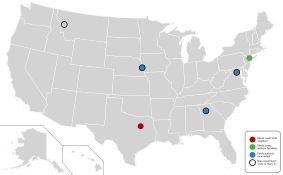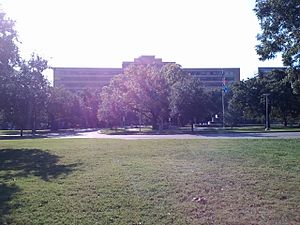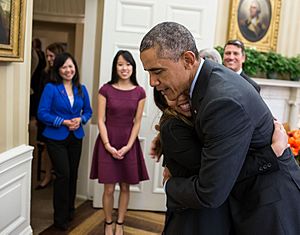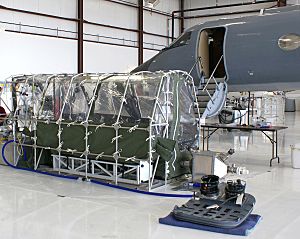Ebola virus cases in the United States facts for kids
Four laboratory-confirmed cases of Ebola virus disease (commonly known as "Ebola") occurred in the United States in 2014. Eleven cases were reported, including these four cases and seven cases medically evacuated from other countries. The first was reported in September 2014. Nine of the people contracted the disease outside the US and traveled into the country, either as regular airline passengers or as medical evacuees; of those nine, two died. Two people contracted Ebola in the United States. Both were nurses who treated an Ebola patient; both recovered.
On September 30, 2014, the Centers for Disease Control and Prevention (CDC) announced that Thomas Eric Duncan, a reportedly 42-year-old (later corrected by CDC reports as a 45-year-old) Liberian national visiting the United States from Liberia, had been diagnosed with Ebola in Dallas, Texas. Duncan, who had been visiting family in Dallas, was treated at Texas Health Presbyterian Hospital Dallas. By October 4, Duncan's condition had deteriorated from "serious but stable" to "critical". On October 8, Duncan died of Ebola. The other three cases diagnosed in the United States as of October 2014[update] were:
- October 11, 2014, a nurse, Nina Pham, who had provided care to Duncan at the hospital.
- October 14, 2014, Amber Joy Vinson, another nurse who treated Duncan.
- October 23, 2014, physician Craig Spencer, diagnosed in New York City; he had just returned from working with Doctors Without Borders in Guinea, a country in West Africa. He was treated at Bellevue Hospital in New York City.
Hundreds of people were tested or monitored for potential Ebola virus infection, but the two nurses were the only confirmed cases of locally transmitted Ebola. Public health experts and the Obama administration opposed instituting a travel ban on Ebola endemic areas, stating that it would be ineffective and would paradoxically worsen the situation.
No one who contracted Ebola while in the United States died from it. No new cases were diagnosed in the United States after Spencer was released from Bellevue Hospital on November 11, 2014.
Cases diagnosed in U.S.
First case: Thomas Eric Duncan
Thomas Eric Duncan in Liberia
Thomas Eric Duncan was from Monrovia, Liberia, to date the country hit hardest by the Ebola virus epidemic. Duncan worked as a personal driver for the general manager of Safeway Cargo, a FedEx contractor in Liberia. According to manager Henry Brunson, Duncan had abruptly quit his job on September 4, 2014, giving no reason.
On September 15, 2014, the family of Marthalene Williams, who later died of Ebola virus disease, could not call an ambulance to transfer the pregnant Williams to a hospital. Duncan, their tenant, helped to transfer Williams by taxi to an Ebola treatment ward in Monrovia. Duncan rode in the taxi to the treatment ward with Williams, her father and her brother.
On September 19, Duncan went to Monrovia Airport, where, according to Liberian officials, Duncan lied about his history of contact with the disease on an airport questionnaire before boarding a Brussels Airlines flight to Brussels. In Brussels, Duncan boarded United Airlines Flight 951 to Washington Dulles Airport. From Dulles, he boarded United Airlines Flight 822 to Dallas/Fort Worth. He arrived in Dallas at 7:01 p.m. CDT on September 20, 2014, and stayed with his partner and her five children, who lived in the Fair Oaks neighborhood of Dallas. Vickery Meadow, the region of Dallas where Duncan resided, has a large African immigrant population and is Dallas's densest neighborhood.
Duncan's illness in Dallas
Duncan began experiencing symptoms on September 24, 2014, and arrived at the Texas Health Presbyterian Hospital emergency room at 10:37 p.m. on September 25. At 11:36 p.m., a triage nurse asked Duncan about his symptoms, and Duncan reported feeling "abdominal pain, dizziness, nausea and headache (new onset)." The nurse recorded a fever of 100.1 °F (37.8 °C), but did not inquire as to his travel history as this was not triage protocol at the time. At 12:05 a.m., Duncan was admitted into a treatment area room where the on-duty physician accessed the electronic health record (EHR). The physician noted nasal congestion, a runny nose, and abdominal tenderness. Duncan was given paracetamol (acetaminophen) at 1:24 a.m. CT scan results came back noting "no acute disease" for the abdominal and pelvic areas and "unremarkable" for the head. Lab results returned showing slightly low white blood cells, low platelets, increased creatinine, and elevated levels of the liver enzyme AST. His temperature was noted at 103.0 °F (39.4 °C) at 3:02 a.m. and 101.2 °F (38.4 °C) at 3:32 a.m. Duncan was diagnosed with sinusitis and abdominal pain and sent home at 3:37 a.m. with a prescription for antibiotics, which are not effective for treating viral diseases.
"What we're seeing now is not an 'outbreak' or an 'epidemic' of Ebola in America. This is a serious disease, but we can't give in to hysteria or fear." – President Barack Obama on the Ebola outbreak
Duncan's condition worsened, and he was transported on September 28 to the same Texas Health Presbyterian Hospital emergency room by ambulance. Duncan arrived in the emergency room at 10:07 a.m., experiencing diarrhea, abdominal pain, and fever. Within fifteen minutes, a doctor noted that Duncan had recently come from Liberia and needed to be tested for Ebola. The doctor described following "strict C.D.C. protocol" including wearing a mask, gown, and gloves. At 12:58 p.m., the doctor called the CDC directly. By 9:40 p.m., Duncan was experiencing explosive diarrhea and projectile vomiting. At 8:28 a.m. the next morning, the doctor noted that Duncan "appeared to be deteriorating." By 11:32 a.m., Duncan was suffering from fatigue severe enough to prevent him from using the bedside toilet. Later that day, Duncan was transferred to an intensive care unit (ICU) after all other patients had been evacuated. The next day, September 30, Duncan was diagnosed with Ebola virus disease after a positive test result.
Duncan's diagnosis was publicly confirmed during a CDC news conference the same day. That evening, Duncan reported feeling better and requested to watch a movie. The following morning, Duncan was breathing rapidly and complaining of "pain all over". By the afternoon, however, he was able to eat, and the doctor noted that he was feeling better. The next day, October 3, Duncan again reported feeling abdominal pain. That evening, the hospital contacted Chimerix, a biotechnology company developing Brincidofovir to combat the disease. The next day, Duncan's organs were failing, and he was intubated to help him breathe. In the afternoon, the hospital began administering Brincidofovir. Nurses Nina Pham and Amber Joy Vinson continued to care for Duncan around the clock. On October 7, the hospital reported that Duncan's condition was improving. However, Duncan died at 7:51 a.m. on October 8, becoming the first person to die in the United States of Ebola virus disease and the index patient for the later infections of nurses Pham and Vinson.
Contact tracing
On October 5, the CDC announced it had lost track of a homeless man who had been in the same ambulance as Duncan. They announced efforts were underway to find the man and place him in a comfortable and compassionate monitoring environment. Later that day, the CDC announced that the man had been found and was being monitored.
Up to 100 people may have had contact with those who had direct contact with Duncan after he showed symptoms. Health officials later monitored 50 low- and 10 high-risk contacts, the high-risk contacts being Duncan's close family members and three ambulance workers who took him to the hospital. Everyone who came into contact with Duncan was being monitored daily to watch for symptoms of the virus, until October 20, when health officials removed 43 out of the 48 initial contacts of Thomas Duncan from isolation. On November 7, 2014, Dallas was officially declared "Ebola free" after 177 monitored people cleared the 21 day threshold without becoming ill.
Reactions
On October 2, Liberian authorities said they could prosecute Duncan if he returned because before flying he had filled out a form in which he had falsely stated he had not come into contact with an Ebola case. Liberian President Ellen Johnson Sirleaf told the Canadian Broadcasting Corporation she was angry with Duncan for what he had done, especially given how much the United States was doing to help tackle the crisis: "One of our compatriots didn't take due care, and so, he's gone there and in a way put some Americans in a state of fear, and put them at some risk, and so I feel very saddened by that and very angry with him.…The fact that he knew (he might be a carrier) and he left the country is unpardonable, quite frankly." Before his death, Duncan brazenly claimed that he did not know at the time of boarding the flight that he had been exposed to Ebola; he said he believed the woman he helped was having a miscarriage, which contradicts corroborated accounts from family members who also helped transport the woman to an Ebola ward.
Duncan's family said the care Duncan received was at best "incompetent" and at worst "racially motivated". Family members threatened legal action against the hospital where Duncan received treatment. In response, Texas Health Presbyterian Hospital issued a statement, "Our care team provided Mr. Duncan with the same high level of attention and care that would be given any patient, regardless of nationality or ability to pay for care. We have a long history of treating a multicultural community in this area." The hospital spent an estimated $500,000 on Duncan's treatment. He had no health insurance.
Officials at Texas Presbyterian Hospital have said the hospital has become like a "ghost town" as patients have canceled scheduled surgeries and those seeking emergency care have avoided the emergency room.
The reaction to the care and treatment of Thomas Duncan, and the subsequent transmission to two of the nurses on his care team, have caused several hospitals to question the extent to which they are obligated to treat Ebola patients. Discussions on curtailing treatment are underway at Geisinger Health System, which operates hospitals in Pennsylvania, and Intermountain Healthcare, which runs facilities in Utah, according to their spokesmen. Their concern surrounds the reality that understaffed and poorly equipped hospitals performing invasive procedures, like renal dialysis and intubation, both of which Duncan received at Texas Presbyterian, could put staff at too much risk for contracting the virus. Emory University Hospital in Atlanta also used renal dialysis in treating patients at their biocontainment unit, but no health care workers became infected. In October 2014 Vickery Meadow residents stated that people were discriminating against them because of the incident.
Second case: Nina Pham
On the night of October 10, Nina Pham, a 26-year-old nurse who had treated Duncan at Texas Health Presbyterian Hospital, reported a low-grade fever and was placed in isolation. On October 11, she tested positive for Ebola virus, becoming the first person to contract the virus in the U.S. On October 12, the CDC confirmed the positive test results. Hospital officials said Pham had worn the recommended protective gear when treating Duncan on his second visit to the hospital and had "extensive contact" with him on "multiple occasions". Pham was in stable condition as of October 12.
On October 16, Pham was transferred to the National Institutes of Health Clinical Center in Bethesda, Maryland. On October 24, the NIH declared Pham free of the Ebola virus. That day Pham traveled to the White House where she met with President Obama.
Controversies and lawsuit
Tom Frieden, director of the Centers for Disease Control and Prevention, initially blamed a breach in protocol for the infection. The hospital's chief clinical officer, Dr. Dan Varga, said all staff had followed CDC recommendations. Bonnie Costello of National Nurses United said, "You don't scapegoat and blame when you have a disease outbreak. We have a system failure. That is what we have to correct." Frieden later spoke to "clarify" that he had not found "fault with the hospital or the healthcare worker". National Nurses United criticized the hospital for its lack of Ebola protocols and for guidelines that were "constantly changing". Briana Aguirre, a nurse who had cared for Nina Pham, criticized the hospital in an appearance on NBC's Today Show. Aguirre said that she and others had not received proper training or personal protective equipment, and that the hospital had not provided consistent protocols for handling potential Ebola patients into the second week of the crisis. A report indicated that healthcare workers did not wear hazmat suits until Duncan's test results confirmed his infection due to Ebola, two days after his admission to the hospital. Frieden later said that the CDC could have been more aggressive in the management and control of the virus at the hospital.
On March 2, 2015 The New York Times reported that Pham filed a suit against Texas Health Resources, her hospital's parent company, accusing it of "negligence, fraud and invasion of privacy". Pham was described as still suffering from numerous physical and psychological problems, listing lack of proper training as the reason for her illness.
Third case: Amber Vinson
On October 14, a second nurse at the same hospital, identified as 29-year-old Amber Vinson, reported a fever. Amber Joy Vinson was among the nurses who had provided treatment for Duncan. Vinson was isolated within 90 minutes of reporting the fever. By the next day, Vinson had tested positive for Ebola virus. On October 13, Vinson had flown Frontier Airlines Flight 1143 from Cleveland to Dallas, after spending the weekend in Tallmadge and Akron, Ohio. Vinson had an elevated temperature of 99.5 °F (37.5 °C) before boarding the 138-passenger jet, according to public health officials. Vinson had flown to Cleveland from Dallas on Frontier Airlines Flight 1142 on October 10. Flight crew members from Flight 1142 were put on paid leave for 21 days.
During a press conference, CDC Director Tom Frieden stated she should not have traveled since she was one of the health care workers known to have had exposure to Duncan. Passengers of both flights were asked to contact the CDC as a precautionary measure.
It was later discovered that the CDC had, in fact, given Vinson permission to board a commercial flight to Cleveland. Before her trip back to Dallas, she spoke to Dallas County Health Department and called the CDC several times to report her 99.5 °F (37.5 °C) temperature before boarding her flight. A CDC employee who took her call checked a CDC chart, noted that Vinson's temperature was not a true fever – a temperature of 100.4 °F (38.0 °C) or higher – which the CDC deemed as "high risk", and let her board the commercial flight. On October 19, Vinson's family released a statement detailing her government-approved travel clearances and announcing that they had hired a Washington, DC, attorney, Billy Martin. As a precaution, sixteen people in Ohio who had had contact with Vinson were voluntarily quarantined.
On October 15, Vinson was transferred to the Emory University Hospital in Atlanta. Seven days later, Vinson was declared Ebola free by Emory University Hospital.
Monitoring of other health care workers
As of 15 October 2014[update], there were 76 Texas Presbyterian Hospital health care workers being monitored because they had had some level of contact with Thomas Duncan. On October 16, after learning that Vinson had traveled on a plane before her Ebola diagnosis, the Texas Department of State Health Services advised all health care workers exposed to Duncan to avoid travel and public places until 21 days after their last known exposure.
Fourth case: Craig Spencer
On October 23, Craig Spencer, a physician who treated Ebola patients in West Africa, tested positive for Ebola at Bellevue Hospital Center after having a 100.3 °F (37.9 °C) fever. Officials said he was hospitalized with fever, nausea, pain, and fatigue. He had flown to New York City from Guinea within the previous ten days, and contacted the city's Department of Health and Doctors without Borders after showing symptoms. Spencer traveled to Guinea to treat Ebola victims on September 16 and returned on October 16. Spencer had been self-monitoring for symptoms of the disease, and began to feel sluggish on October 21, but did not show any symptoms for two days. His case was the first to be diagnosed in New York. The city was trying to find people who may have been in contact with Spencer between October 21–23.
On October 22, the day before he had symptoms, Spencer rode the New York City Subway, walked on the High Line park, went to a bowling alley and a restaurant in Brooklyn, took an Uber cab to his home in Manhattan, and took a 3-mile (4.8 km) jog in Harlem near where he lived. Three other people who were with Spencer in the previous few days were quarantined as well. Spencer's apartment and the bowling alley he went to were cleaned by hazmat company Bio Recovery Corporation. Health officials stated it was unlikely that Spencer could have transmitted the disease through subway poles, hand railings, or via bowling balls.
New York hospitals, health-workers, and officials had conducted weeks of drills and training in preparation for Craig Spencer. Upon arrival at the hospital, he was put in a specially designed isolation center for treatment. Not many details about the treatment were given, except that he participated in decisions relating to his medical care. On October 25, the New York Post reported that an anonymous source had said that nurses at Bellevue had been calling in sick to avoid having to care for Spencer. A hospital spokesperson denied there was a sick out. On November 1, his condition was upgraded to "stable", and on November 7 the hospital announced he was free of Ebola. Spencer was released from the hospital on November 11. He was cheered and applauded by medical staff members, and hugged by the Mayor of New York, Bill de Blasio as he walked out of the hospital. The Mayor also declared: "New York City is Ebola free".
As a result of Spencer's Ebola case, U.S. Senator Charles Schumer (D-NY), has proposed an Ebola fund in an omnibus bill to be considered in fiscal year 2015. Schumer said the funds are needed to compensate New York City, as well as other cities treating Ebola patients, in the same way the federal government covers communities that suffer after a natural disaster. Schumer said Craig Spencer's care at Bellevue Hospital involved around 100 health care workers. In addition, the city's health department has established a 24-hour-a-day operation involving 500 staffers to keep track of the approximately 300 persons from West Africa hot spots who arrive in New York every day.
Containment efforts
Operation United Assistance
The U.S. military released plans to send up to 4,000 troops to West Africa to establish treatment centers starting September 29. The troops are tasked with building modular hospitals known as Expeditionary Medical Support Systems (EMEDS). Plans included building a 25-bed hospital for health care workers and 17 treatment centers with 100 beds each in Liberia. By the end of September 2014 150 military personnel were helping USAID in the capital, Monrovia.
U.S. Army Chief of Staff Ray Odierno ordered on October 27 a 21-day quarantine of all soldiers returning from Operation United Assistance. Up to 12 soldiers have been quarantined so far in a U.S. base in Italy.
Revised CDC guidelines
Since 2007, US hospitals have relied on CDC infection control protocols to contain Ebola virus disease. Until October 20, 2014, the CDC guidelines allowed hospitals wide latitude to select gear based on interaction between healthcare workers and patients and on the mode of transmission of the disease being handled. The guidelines suggested gowns with "full coverage of the arms and body front, from neck to the mid-thigh or below, will ensure that clothing and exposed upper body areas are protected", and additionally recommend masks and goggles.
Some infection control experts said that many American hospitals improperly trained their personnel to handle Ebola cases because they were following federal guidelines that were too lax. US officials abruptly changed their guidelines on October 14. The New York Times stated that this was an effective acknowledgment that there were problems with the procedures for protecting health care workers. Sean Kaufman, who oversaw infection control at Emory University Hospital while it treated Ebola patients, has said the previous CDC guidelines were "absolutely irresponsible and dead wrong". Kaufman called to warn the agency about its lax guidelines but, according to Kaufman, “They kind of blew me off.”
A Doctors Without Borders representative, whose organization has been treating Ebola patients in Africa, criticized a CDC poster for lax guidelines on containing Ebola, saying, “It doesn't say anywhere that it’s for Ebola. I was surprised that it was only one set of gloves, and the rest bare hands. It seems to be for general cases of infectious disease.”
The national nursing union National Nurses United criticized the CDC for making the guidelines voluntary. There were complaints at the Texas hospital that healthcare professionals had to use tape to cover their exposed necks. According to Frieden, the CDC is appointing a hospital site manager to oversee Ebola containment efforts and are making "intensive efforts" to retrain and supervise staff.
On October 14, the WHO reported that 125 contacts in the United States were being traced and monitored. On October 20, the CDC updated its guidance on Personal Protective Equipment with new detailed instructions that include specifying that no skin should be exposed and adding extensive instructions for donning and doffing the equipment. On October 20 CDC updated its guidance to add clarification that Ebola may spread through wet droplets such as sneezes.
Treatment
Biocontainment units in the U.S.
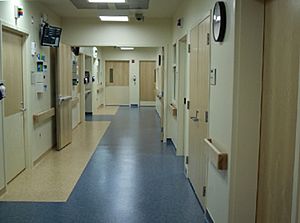
The United States has the capacity to isolate and manage 11 patients in four specialized biocontainment units. These include the University of Nebraska Medical Center in Omaha, Nebraska, the National Institutes of Health in Bethesda, Maryland, St. Patrick Hospital and Health Sciences Center in Missoula, Montana and Emory University Hospital in Atlanta, Georgia.
Experimental treatments
There is as yet no FDA-approved medication or vaccine. The director of the US National Institute of Allergy and Infectious Diseases, Dr. Anthony Fauci, has stated that the scientific community is still in the early stages of understanding how infection with the Ebola virus can be treated and prevented. There is no cure or specific treatment that is currently approved. However, survival is improved by early supportive care with rehydration and symptomatic treatment. Treatment is primarily supportive in nature. A number of experimental treatments are being considered for use in the context of this outbreak, and are currently or will soon undergo clinical trials.
In late August 2014, both Kent Brantly and Nancy Writebol became the first people to be given the experimental drug ZMapp. They both recovered, but there was no confirmation or proof that the drug was a factor. A Spanish priest with Ebola had taken ZMapp but died afterward. Up until that time, ZMapp had only been tested on primates and looked promising, causing no serious side effects and protecting the animals from infection. The Bill & Melinda Gates Foundation has donated $150,000 to help Amgen increase its production, and the U.S. Department of Health and Human Services has asked a number of centers to also increase production.
There have been at least two promising treatments for those already infected. The first is Brincidofovir, an experimental antiviral drug, which was given to Duncan, Mukpo, and Spencer.
Treatment using a transfusion of plasma from Ebola survivors, a form of “passive immunotherapy,” since it contains antibodies able to fight the virus, has been used with apparent success on a number of patients. Survivor Kent Brantly donated his blood to Rick Sacra, Ashoka Mukpo and nurse Nina Pham. The World Health Organization (WHO) has made it a priority to try the treatment, and has been telling affected countries how to do it.
Experimental preventative vaccines
Many Ebola vaccine candidates had been developed in the decade before 2014, but none has yet been approved for clinical use in humans. Several promising vaccine candidates have been shown to protect nonhuman primates (usually macaques) against lethal infection, and some are now going through the clinical trial process.
In late October 2014, Canada planned to ship 800 vials of an experimental vaccine to the World Health Organization (WHO) in Geneva, the drug having been licensed by NewLink Genetics Corporation, of Iowa. British drugmaker GlaxoSmithKline also announced it had expedited research and development of a vaccine, which, if successful, could be available in 2015. Although it's still unknown which ones will be approved, WHO hopes to have millions of vaccine doses ready sometime in 2015, and expects that five more experimental vaccines will start being tested in March 2015.
Public reactions
In October 2014, Navarro College, a two-year public school located in Texas, received media attention for admission rejection letters sent to two prospective students from Nigeria. The letters informed the applicants that the college was "not accepting international students from countries with confirmed Ebola cases." On October 16, Navarro's Vice-President Dewayne Gragg issued a statement confirming that there had indeed been a decision to "postpone our recruitment in those nations that the Center for Disease Control and the U.S. State Department have identified as at risk." Nigeria's outbreak was among the least severe in West Africa and was considered over by the WHO on 20 October; the Nigerian health ministry had previously announced on 22 September that there were no confirmed cases of Ebola within the country.
In October 2014, the S. I. Newhouse School of Public Communications at Syracuse University withdrew an invitation it had extended to Pulitzer Prize winning photojournalist Michel du Cille because he'd returned three weeks earlier from covering the Ebola outbreak in Liberia. In October 2014, Case Western Reserve University withdrew their speaking invitation to Dr. Richard E. Besser, chief health editor at ABC News and former director of the Centers for Disease Control. Besser had recently returned from a trip to Liberia.
On October 17, Harvard University imposed limits on travel to Ebola-affected countries (Sierra Leone, Guinea and Liberia) for its students, staff, and faculty. All travel to these countries is "strongly discourage[d]", and such travel as part of a Harvard program requires approval from the provost.
On October 25, CDC allowed state and local officials to set tighter control policies and Barbara Reynolds, a CDC spokeswoman released a statement saying "we will consider any measures that we believe have the potential to make the American people safer". On November 1, Ohio tightened restrictions on people travelling to Western African countries impacted by Ebola.Time Magazine's 2014 Person of the Year issue honored health professionals dedicated to fighting Ebola, including Kent Brantly.
Images for kids
-
Ebola screening of a passenger who arrived from Sierra Leone at Chicago's O'Hare airport


